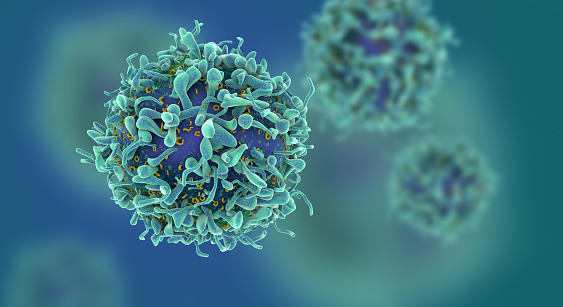
Drugmaker Gilead Sciences has its sights set on a second approval for its CAR-T cell therapy following the release of data from its clinical trial in slow-growing non-Hodgkin’s lymphomas at a large cancer conference.
The Foster City, California-based company announced the presentation of data from the Phase I/II ZUMA-5 study of Yescarta (axicabtagene ciloleucel) in patients with relapsed or refractory indolent NHL, including follicular lymphoma (FL) and marginal zone lymphoma (MZL), at the American Society of Clinical Oncology’s annual conference. The CAR-T has been on the market for nearly three years for diffuse large B-cell lymphoma (DLBCL), an aggressive form of NHL, in which it competes with Novartis’ Kymriah (tisagenlecleucel).
Shares of Gilead were mostly flat on the Nasdaq Friday following the announcement.
Among 96 patients evaluable for efficacy – including 80 with FL and 16 with MZL – 93% responded, with 80% having a complete response. The median duration of response was 20.8 months, with a median follow-up of 15.3 months. Median progression-free survival was 23.5 months, while the median overall survival was not reached. The safety analysis included 140 patients, with 8% experiencing severe or worse cytokine release syndrome and 17% experiencing neurological toxicities of similar severity. One FL patient died from complications related to CRS, while another died from causes unrelated to Yescarta.
“Most patients responded, with an over 90% response rate and an 80% complete response rate, which is quite impressive,” said Dr. Caron Jacobson, medical director of the cell therapy program at Dana-Farber Cancer Institute and presenter of the study results, in a phone interview.
Meanwhile, Ibrahim Elhoussieny, VP and head of global medical affairs at Gilead subsidiary Kite Pharma, said the efficacy data compare favorably with those of existing mono therapy treatment options like Bristol-Myers Squibb’s Revlimid (lenalidomide), AbbVie’s Venclexta (venetoclax) and Gilead’s Zydelig (idelalisib). “These agents have delivered about 12-14% complete response rates, so that makes the space a little bit fragmented because there’s no clear winner,” he said in a phone interview, pointing also to combination therapies that yield CR rates of up to 44%.

What Are Healthcare Organizations Getting Wrong about Email Security?
A new report by Paubox calls for healthcare IT leaders to dispose of outdated assumptions about email security and address the challenges of evolving cybersecurity threats.
However, Yescarta’s response rate advantage does not necessarily mean it will replace the oral drugs.
“It’s going to be a complicated conversation to have with patients,” said Dr. Amanda Cashen, an associate professor of medicine at Washington University in St. Louis who uses CAR-T therapies at her center, in a phone interview. “Having to take those expensive oral drugs continuously, potentially for many years, is a burden for many patients, especially once you suffer from some chronic side effects or have trouble paying the copays for those drugs.”
Jacobson noted that the indolent NHL patients for whom Yescarta is being developed are those who are in their third line of treatment or later. While some patients that late in the natural history of their disease don’t require another line of treatment within their lifetime, there is a subset of patients who do.
“There are lots of other things that are available and plenty of other options available to patients in this setting,” Jacobson said. “The decision to do one of those versus CAR-T cell therapy is really a discussion with the patient.”
That means taking into account factors like what patients have had previously, their age and how long their last remission lasted. Thus, Yescarta could be an option for those patients who want a treatment with a high likelihood of getting them into a long-lasting remission. “But if the patient is 86 and wants something they’re going to tolerate better and that will pose minimal risk, and they live far away – and there are a lot of other personal and psychosocial factors that go into it – then one of those other options may be a good option,” Jacobson said.
In terms of the safety profile, the rates of CRS and neurotoxicity were lower than has been seen with Yescarta in DLBCL, but the onset of CRS also took longer – a median of four days in indolent NHL, compared with two days for DLBCL. Elhoussieny said the reason for that is unclear and a topic of ongoing analysis. “One of the hypotheses might be the tumor burden in indolent NHL,” he said, noting that can have an effect on the safety profile. “That might have also contributed to the lesser incidence of Grade 3 and above neurological adverse events.”
Elhoussieny and Jacobson said the toxicity profile opened the possibility of the therapy being used on an outpatient basis, something that has already been explored with other CAR-Ts like BMS’ lisocabtagene maraleucel – also being developed for NHL – and Johnson & Johnson’s JNJ-4528 in multiple myeloma.
But Cashen said another potential factor in the lower rates of toxicity is that centers have simply become better at managing them.
“In my experience the toxicity is less than what was reported in trials because we’re getting better at managing the toxicity,” Cashen said, referring to the experience with CAR-Ts in DLBCL. “We’re quicker to intervene with [Roche’s Actemra (tocilizumab) and steroids than when we first started using CAR-Ts.”
Photo: CGToolbox, Getty Images








